
27 minute read
letter from the head of
Blessed with a Steady Crew

My favorite line in the Cardigan hymn comes toward the end: “through storm or weather fair.” It’s emblazoned on a sign which hangs over my office door, and it has been, and continues to be, an apt reminder and motivator to us all, especially over the last nine months and for the foreseeable future. But perhaps it would be more appropriate if the sign were to read “through storm and weather fair”; our existence lately has been as frenetic and variable as New England’s weather—filled with moments of turbulent uncertainty as well as moments of blissfully fair sailing and celebration.
On the one hand, we are dealing daily with a relentless pandemic that has interrupted the routines and programs familiar to our School and threatens the health and safety of every member of our community. It took extraordinary measures and flexible thinking to open our doors in August to the boys who want, and deserve, to study and develop here. And maintaining our status has required a commitment from every member of this community: students, staff, faculty, family, and friends. I have been particularly impressed by the students, who are doing great, despite the fact that it’s tough to wear masks most of the time, tough to train for sports in which the opponents they face on Saturdays are practicing alongside them and wearing the same colors. But to watch these boys practice, one would think that they were preparing for a tilt against our rivals from Eaglebrook!
At the same time, we have been celebrating a trifecta of impressive accomplishments: the completion of a 12-year strategic plan, the success of e Campaign for Cardigan 2020, and the anniversary of our founding 75 years ago. ose who haven’t been to campus recently will likely marvel at the physical changes at Cardigan. And peeling back a layer or two will reveal that the physical transformation to Cardigan’s campus is the result of a strengthening and evolving program, and a responsible stewardship of resources, as we work to secure a bright future for the boys and families who have yet to discover Cardigan. Our successes are directly tied to our mission and the hard work of countless individuals who have kept us focused and striving for our goals.
None of this would have been possible without the tireless effort of so many members of this community. We have done this together, and I am grateful to everyone for our success to date—in both fighting this global pandemic and in completing a very successful campaign.
Tomorrow, next week, and next month still lie ahead of us, and we will face new challenges; but knowing that this School has the support of every individual in it gives me hope and optimism for what is to come. e stories and features in this Chronicleare examples of the kind of crew members we are blessed to have as we steer a steady course…through storm and weather fair.
I want to welcome all members of the Cardigan family to this edition of the Chronicle. More than a brochure which highlights the sunny days and smiling faces of Cardigan (of which there are many), this publication blends images with stories—both contemporary and historical—to invite the reader into the dynamic life of a school for middle school boys. I couldn’t be more proud of this community and family; I hope that this Chronicleprovides you with a sense of pride and motivates you to lean in and help us write the next chapter of this great story. r
Christopher D. DayP’12,’13 Head of School
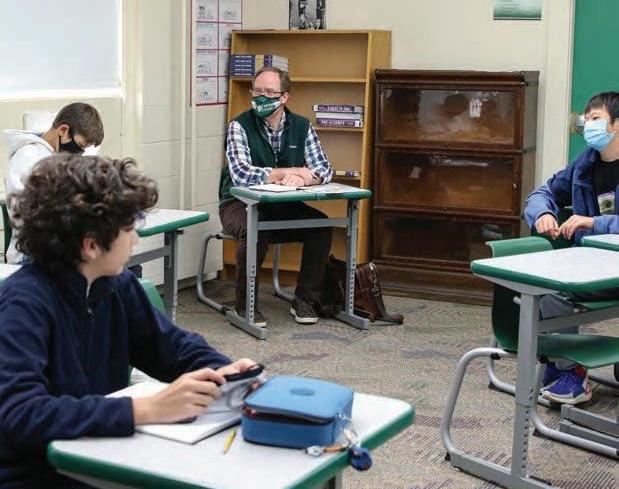

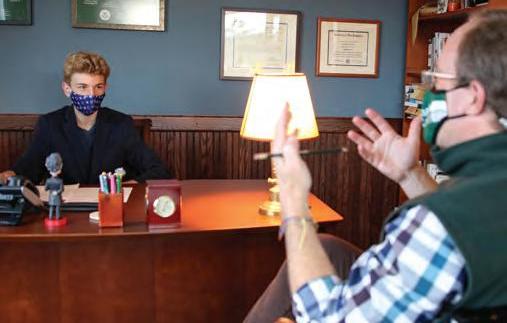
as Cardigan’s annual tradition diCtates, head of sChool Chris day p’12,’13 and hudson heinemann ‘22 met in the head of sChool’s offiCe first thing on a
monday morning in oCtober and exChanged sChed-
ules. while hudson got the opportunity to find out
what it’s like to be the head of the sChool for a day,
mr. day got to be a student, attending english Class,
taking a test in math, and even trying out the new tools in wallaCh's woodshop.
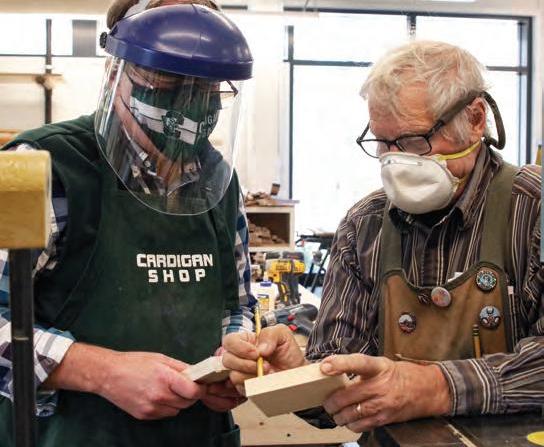


Up and to the Right: The Execution of an Audacious Campaign
Any good campaign must begin with “why.” Why take on the task of developing support and raising funds for a particular cause? In the case of Cardigan, that answer has always been easy.
We do it for the boys.
By Emily Magnus
Every year, a new group of students arrives on campus, most of them leaving their homes and families in pursuit of a more robust education. They come to us with open minds and ask that we share our knowledge—whether it be solving for x, or executing the perfect slap shot, or leading with compassion and service. On a fundamental level, the boys are here for their own personal gains, but there’s also the possibility that their education, if executed with Cardigan’s mission in mind, will lead to a better world.
That’s what the Cardigan trustees were thinking in 2010, when they began to formulate a plan for what they wanted Cardigan to look like in 2020. Their vision was bold and bigger than anything Cardigan had ever attempted before. The most the School had ever tried to raise in its 60-year history was $8 million; the goal this time was $50 million and called for building a new community center, renovating several dorms and facilities, and improving the work/life balance for faculty and staff, as well as increasing the endowment by $10.8 million. Many doubted it was possible.
“We took on the campaign recognizing there was some degree, a relatively large degree, of probability that we could fail,” remembers former Board Chair and Finance Committee Vice Chair Hank Holland H’18, P’12,’15. “It was intentionally an
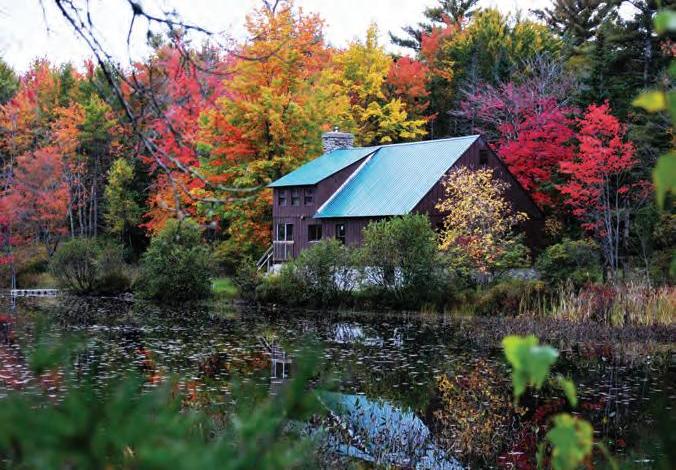
2011 2011
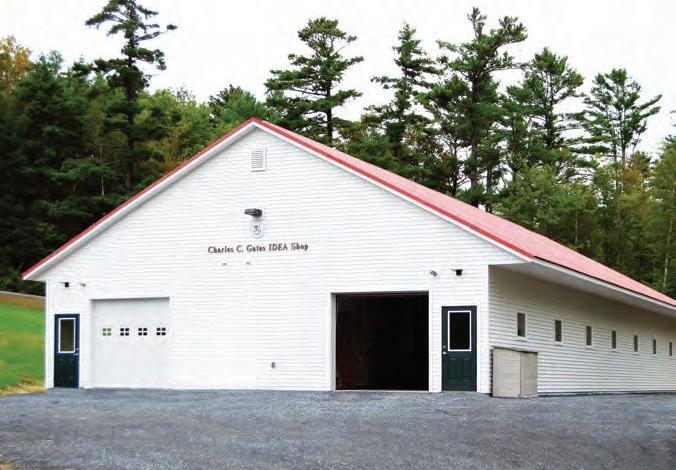
2011: The Charles C. Gates I.D.E.A. Center is erected to house the invention and innovation program; the woodshop is relocated at the same time to centralize academic programming. The C.O.R.E. Base Camp is renovated to enhance outdoor education programming and foster environmental stewardship.
audacious goal. And I think, had we achieved 90% of the goal, we probably collectively would have been very happy. Little did we know we would achieve 125% of the goal.”
STATE OF THE SCHOOL
Let’s set the scene. In the early 2000s, Cardigan Mountain School was simultaneously leading junior boarding schools and falling behind in various aspects of its program. On the positive side, the School had recently constructed two 12-bed dorms as well as the Wakely Center and new fitness facilities. In a 2007–08 review of the School, consultant Nancy Stearns wrote, “The athletics program is one of the major program assets at Cardigan. Solid leadership and coaching, a wide range of options for the boys, and high enthusiasm from both adults and students for participation and sportsmanship imbue this department. I believe all the right issues are being addressed at this time.”
The physical and mental health of the boys and the Cardigan community had received significant attention as well under the leadership of Head of School Cameron “Chip” Dewar H’02, P’93 (1990–2004) and Interim Head of School Jamie Funnell (2004–05). These efforts finally came to fruition early in the tenure of Head of School Thomas Needham (2005–07), with the longawaited dedication of the Hamilton Family Foundation Health Center and the addition of new health services staff.
At the same time, however, there was a period of rapid transition, and an accompanying uncertainty about the School’s future ensued. Routine maintenance had, out of necessity, been deferred on many occasions, and as the number of students increased, little had been done to provide a space in which the community could gather. The Hayward Dining Hall, in fact, was operating routinely beyond its intended capacity of 150.
“We had just four ovens and one grill to produce [three meals a day] for 178 kids, plus approximately 120 to 150 faculty and staff members (and their respective family members),” recalled former Director of Dining Services Bob Spano H’18 in a 2016 reflection. “We were able to just barely keep up with the demand of the business; we had to use a lot of premade products and take many shortcuts. In fact, we used to pray for winter because of the ‘cold storage' it provided for us!”
Also in dire need of attention was faculty compensation, benefits, and workload. Funding was necessary to bolster professional development initiatives, and housing was an issue, as each June, faculty were required to vacate their residences to make room for Summer Session staff. Salaries were not competitive with peer schools, and the work-life balance was often skewed heavily in the direction of work.
Furthermore, the national climate beyond the Cardigan campus was unfavorable to the fundraising efforts of the Development Office. With the Great Recession in 2008, families were both less willing and less able to contribute to a small junior boarding school in central New Hampshire.
In spite of these challenges, the community still believed in the School’s mission and Core Values. The campus provided plenty of room for boys to explore and grow, developing their confidence and moral character through the four-year program. The faculty maintained a reputation of caring deeply for the boys under their supervision, and the academic program was gaining momentum with the introduction of the Gates Invention &

2012 2013
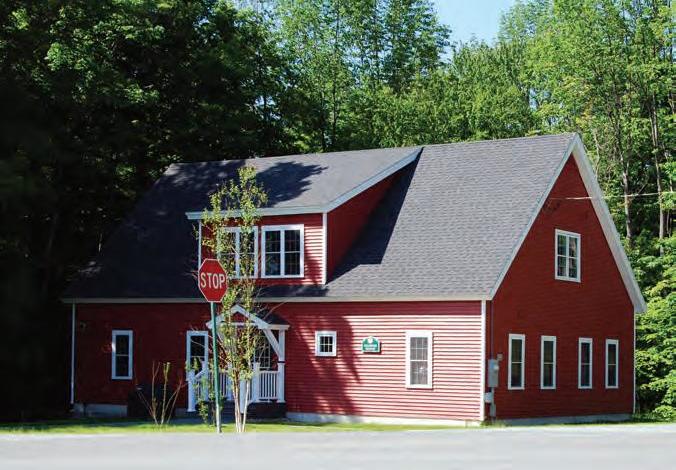
2012: Pearson House is renovated for faculty housing to begin addressing the quality of life of faculty. 2013: The Maintenance Center is built to provide the Facilities Department with the tools and resources needed to support the School’s program and community.
Innovation Competition. All of the intangible but essential ingredients were there; the school just needed the right leadership and significant financial investment to help it flourish.
BUILDING A PLAN
“You have to remember that the 2007–09 period was similar to what we’re experiencing right now with respect to the nation’s economic situation,” remembers former Head of School Dave McCusker ’80, P’09,’10, who was hired in 2007 to help the School begin a new chapter. “That was a period of tremendous upheaval and uncertainty. And to the board’s credit, we didn’t just hunker down and try to weather the storm. We made an intentional decision to really grow and plan significantly during that period.”
The board’s Strategic Planning Committee, under the guidance of committee chair Burt McGillivray P’07,’09,’09, began by creating individual task forces—comprised of both trustees and members of the faculty—to assess not only the School’s financial situation, but also its competitive positioning, external market considerations, academic year and summer programming, and issues pertaining to staffing. Ultimately, the plan focused on five areas: (1) program refinement and support, (2) leadership and support, (3) physical plant improvements, (4) financial sustainability commitment, and (5) the telling of the Cardigan story.
“Our goal is to put in place a strategic plan framework that is a living document,” wrote Mr. McCusker in The Strategic Plan for Cardigan 2020, “one that is used regularly to guide our decision making, and to measure our progress toward outcomes that are both ambitious and comprehensive in nature…By charting a course toward refining and enhancing the School’s distinctive program—while being mindful of the needs of people and resources needed to deliver it—this document, and the tactical plans that develop from it, will be an integral player in our success.”
The strategic plan called for developing mission-driven programs that were innovative, relevant, and responsive, and for attracting and retaining exceptional, collaborative faculty and staff through professional development, competitive compensation/benefits, and a healthy residential culture. It also called for an enrollment strategy that would ensure a diverse student body and a campus master plan focused on building and maintaining functional, environmentally responsible facilities that also support the programs and people. Finally, it called for financial resources that could be maintained in perpetuity and preserve intergenerational equity.
“The recommendations and strategic priorities are thoughtful, relevant, and important to the achievement of Cardigan’s mission,” wrote Mr. McGillivray in The Strategic Plan for Cardigan 2020. “…As we move from planning to action, we do so with the confidence that we are focused on the most critical goals for Cardigan’s success, that they are achievable goals, and that they will drive the success of Cardigan for many years to come.”
BUILDING THE TEAM
The plan, however, wasn’t enough. It needed cheerleaders, people unified by their belief in it and motivated to see it through to the end.
The individuals who dedicated their time to The Campaign for Cardigan 2020 were diverse in their perspectives, and the
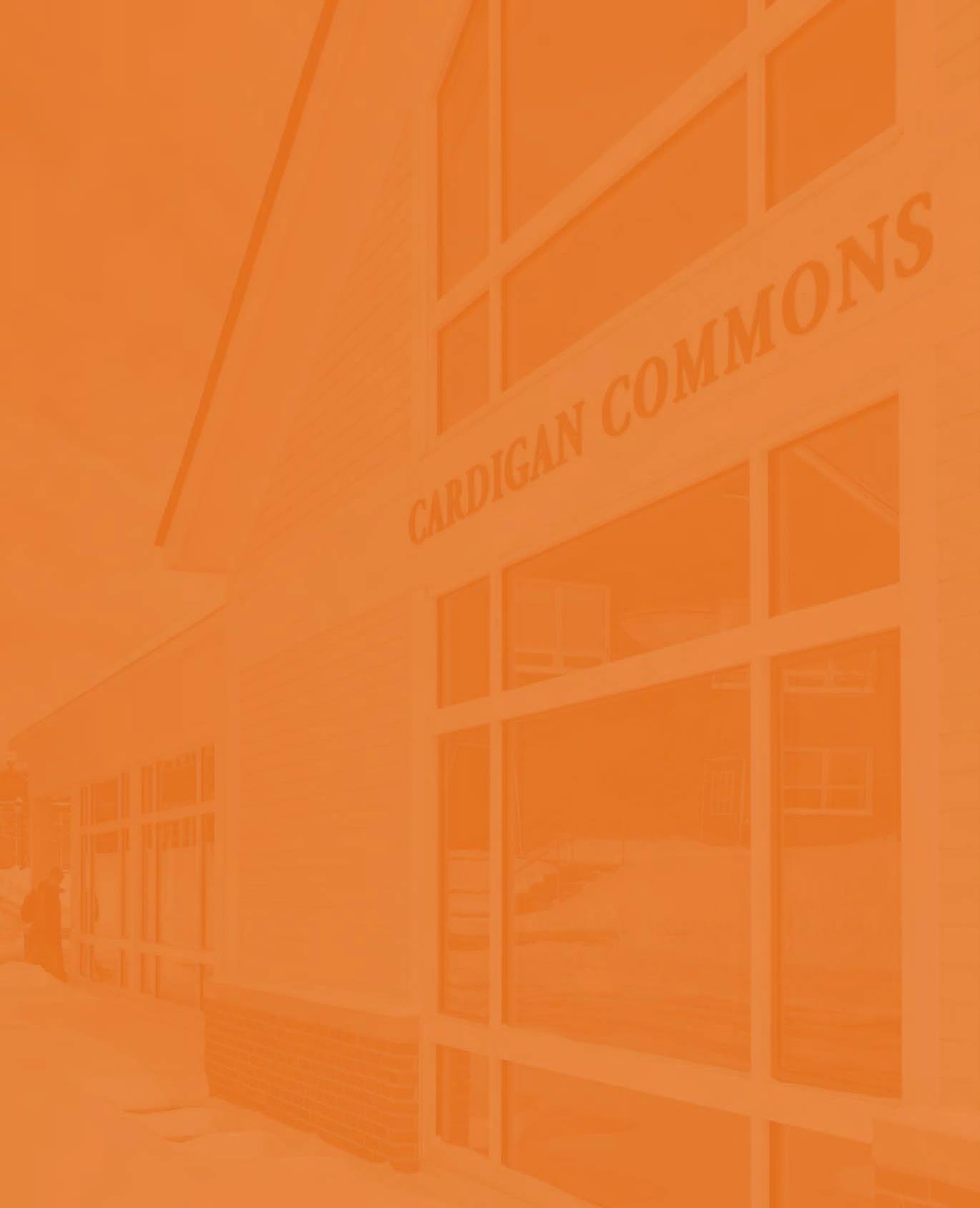
By Stephen Solberg
Sister Irene Krause from the Daughters of Charity National Health Care System is credited with the phrase, “No Margin, No Mission.” It underscores the reality for all nonprofits: delivering on one’s mission is completely unrelated to, yet absolutely dependent on, one’s ability to establish reliable streams of revenue while managing expenses.
The Strategic Planning Committee at Cardigan has recognized that fact from the beginning of their process, and developed (1) goals for good financial stewardship based on a clear understanding of the then-current landscape; (2) a plan for improving Cardigan’s market position through investments in our facilities, staff, and students; and (3) a focus on responsible stewardship of resources, in both the short-term (budget) and long-term (endowment). As a result of their efforts, Cardigan now finds itself in a much more sustainable position, looking confidently toward the future while continuing to value the inherent wisdom of that simple phrase.
In the book Good to Great, author Jim Collins posits that successful organizations must combine an unyielding sense of optimism with a willingness to “infuse the entire process with the brutal facts of reality” (69). Trustee Burt McGillivray P’07,’09,’09, one of the leaders of the Strategic Planning Committee, recently reflected on the committee’s willingness to embrace the challenges of the time as well as those specific to Cardigan: “The 2000s were a rough time for Cardigan, with several leadership changes, issues with our physical plant, program, and faculty, heightened competition with peer schools, and the 2008–09 crash that affected all schools.”
Instead of running from these realities, the committee dug in, performing market analysis to identify Cardigan’s strengths and weaknesses relative to its Junior Boarding School Association (JBSA) peers. Their work found Cardigan’s focus on boarding and middle school boys to be a relative and enduring strength, but identified shortcomings in our facilities, program, and staff compensation relative to our peers. Further, they found that expanding operational and strategic financial support beyond tuition would be critical to the long-term sustainability of the School.
Those non-tuition resources include the Annual Fund, which grew significantly during The Campaign for Cardigan 2020. It now provides greater support for annual operations, relieving pressure on tuition. The endowment has also expanded through the establishment of The Endowment for Excellence Fund, the McCusker Legacy Fund, and facilities endowments for the Cardigan Commons, Clark-Morgan Hall, McCusker Hall, and Wallach. Even as we have grown Cardigan’s endowment, we have strategically reduced our annual draw as a percentage of market value. We have also developed new strategies for expanding endowed funds in general: the goal is to preserve generational equity while moderating our long-term dependence on tuition.
On the other side of the balance sheet, we have adopted new budget processes to develop realistic annual goals for expenses and work within our means. Critical to these processes is prioritizing expenses so as to balance short-term and long-term needs. We base conservative enrollment and revenue goals on available data, and while we are constantly looking for ways to be more efficient in our expenses, we continue to invest in wages/benefits, program needs, and the health of our physical plant.
Mr. Day has stated that our mission as a school has never been more important given the challenges and uncertainties present in our world. With this in mind, Sister Krause’s mantra “No Margin, No Mission” has never been more relevant. To support the boys of Cardigan, we must continue to financially navigate a rapidly changing world, planning realistically and investing strategically, all while balancing the short- and long-term
health of our school. r
endowment 2010–19
millions of dollars
29.5
23.4 29.0
28.3 30.9
32.3 34.4
12.7 14.5
15.4
2010 2011 20192018201720162015201420132012
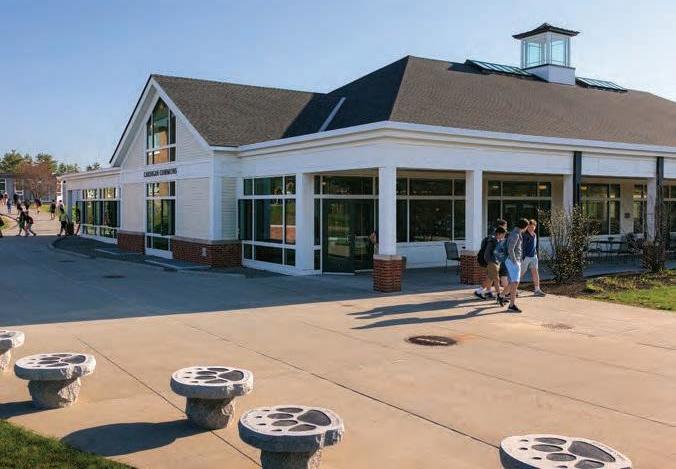
2013 2013
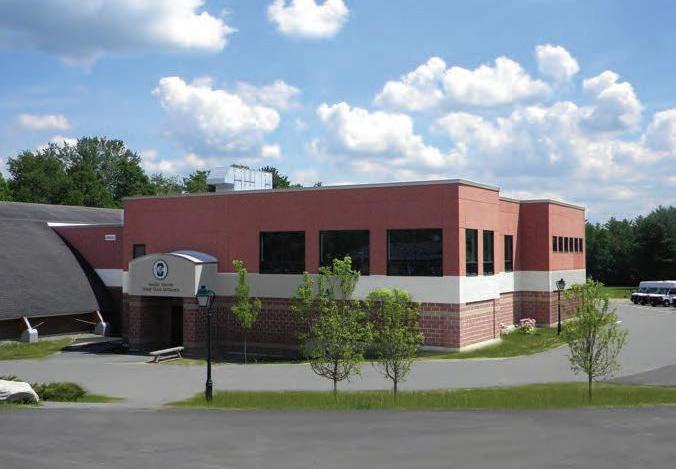
2013: The athletic complex is renovated to support the health of the community and promote a competitive athletic and fitness program based on current scientific research and coaching philosophies. Cardigan Commons is constructed to support campus unity and provide a central location for gatherings, meetings, and student activities.
expertise each member brought to the committee and the respect each one had for the others coalesced into an incredibly strong team. Collectively, they inspired the community and convinced everyone with whom they spoke that their goals were both necessary and achievable. It’s easy to imagine the members of the Campaign Committee gathered around a conference table, their bodies leaning in towards each other, their dialogue animated and intense. They didn’t always agree on the tactical plans, but they were in it for the long haul.
The chair of Cardigan’s Board of Trustees when the campaign began was F. Corning “Kim” Kenly III ’68. As an alumnus and long-time member of the board, Mr. Kenly had the advantage of longevity and a knowledge of what had worked, and not worked, in the past. He was also open to the possibilities of a new future for Cardigan.
“Real leaders aren't just committed to an initiative or an organization when everything is going well,” explains Mr. McCusker. “Real leaders remain faithful through thick or thin, and Kim deserves tremendous credit for his commitment and perseverance. And when I was hired, I was completely unproven; there was no guarantee that I was the right leader for the School. But Kim was a remarkable partner from the start. And what I most appreciated? We debated things, but he kept an open mind.”
Mr. Kenly is equally complimentary of the contributions of Mr. McCusker: “I think the nucleus of the team was Dave McCusker. He kept everything moving, and he had high expectations for the staff. He never let up with us on the board, and he had a vision that we all bought into. Every time we hit barriers, he would find ways around them.”
If Mr. McCusker provided the plan, it was David “Marty” Martinelli P’13 who provided the energy. “I still can relive those board meeting conversations,” says Mr. Kenly, “when Marty said, ‘Hey listen, David [McCusker] has put together a great plan. These are all needs for the School. We all are here because we want the School to do well. If not now, when?’ He was really phenomenal in igniting the match to get us to wake up.” It’s worth noting that Mr. Martinelli coined the phrase, “Up and to the right,” often used as a rallying cry during the campaign.
Also important to the team was Hank Holland H’18, P’12,’15, whose financial expertise provided a fundamental shift in the School’s financial practices. “Hank provoked a lot of out-of-thebox thinking, and he pushed us when we needed to be pushed,” Mr. McCusker remembers. “Hank educated the board about how to best take advantage of historically low interest rates that would complement and extend our fundraising and help achieve our strategic goals.”
The list of individuals who contributed to the campaign continued to grow. Even as the years passed, the momentum of the campaign did not falter, despite changes in board members and committee chairs. Ms. Wallach, Mr. Holland, and Jeremy Crigler’79 all took turns leading the board, while Ms. Wallach, Chris Welles P’08, Mr. Martinelli, and Karl Hutter ’92 chaired the Campaign Committee. Members of the Development Office were also an integral part of the team, including former Director of Development David Perfield, Director of The Campaign for Cardigan 2020 Sandy Hollingsworth (now Cardigan’s Director of Leadership and Planned Gifts), and current Director of Development and International Relations Joe Burnett ’95. “The leadership style, the talents, and the commitment that each indi-
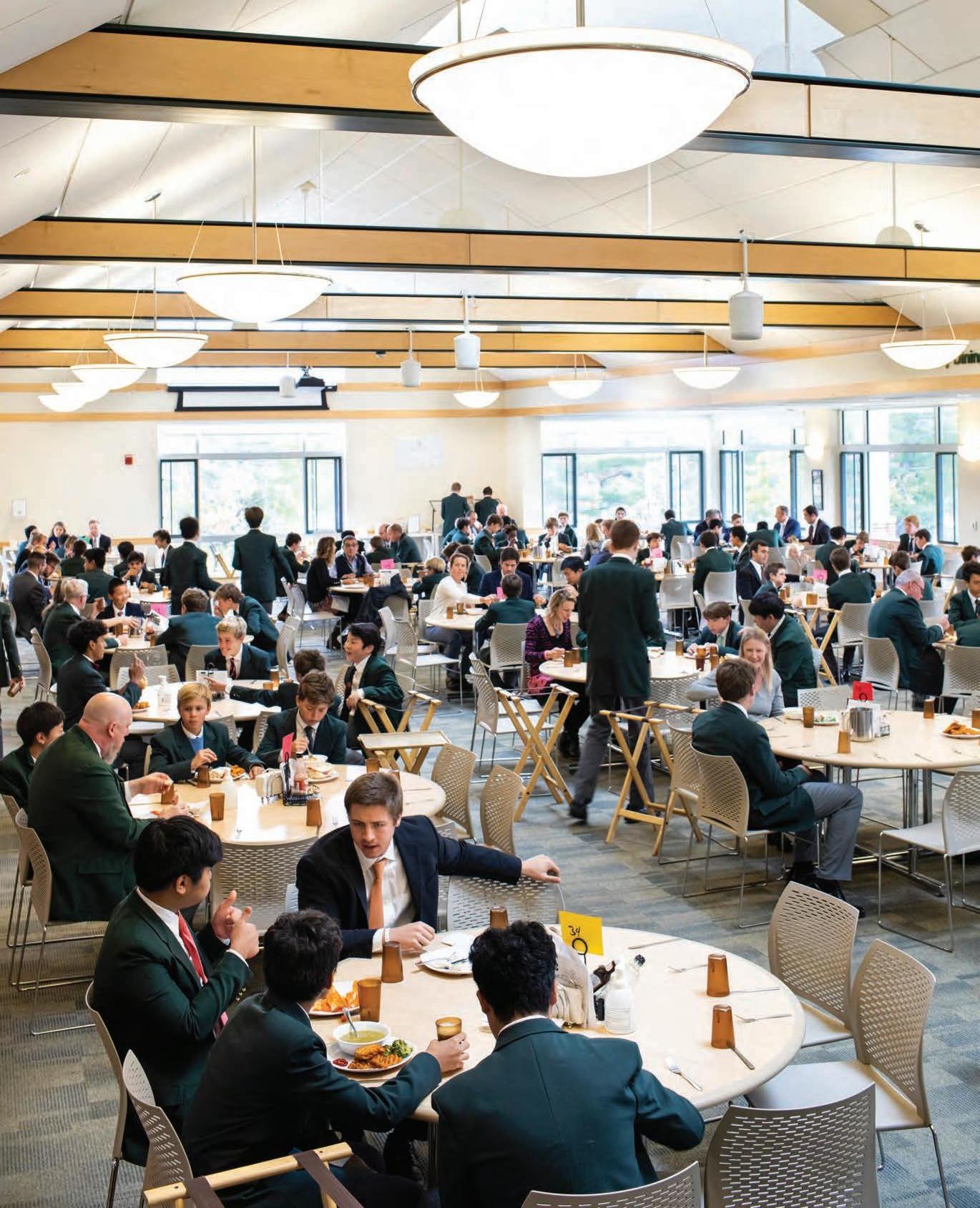

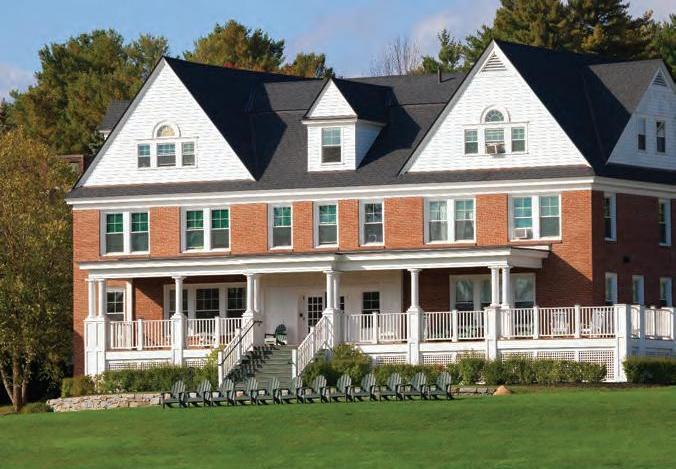
2014 2015
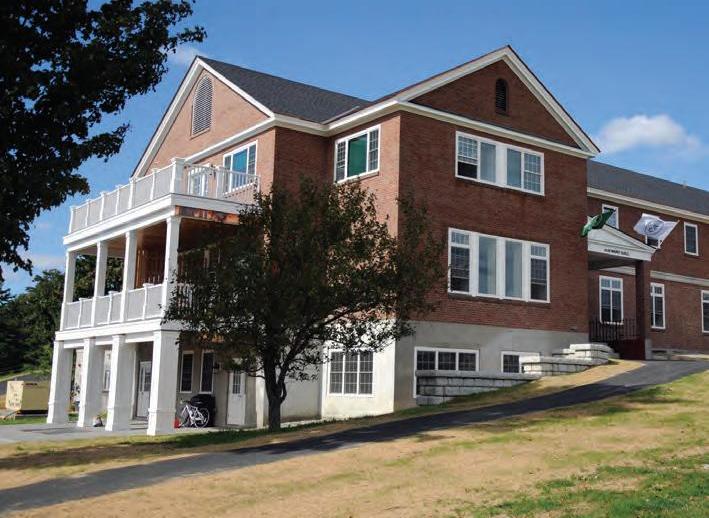
2014: Hayward Hall is renovated to provide faculty and students with updated housing and begin to address the need for Summer Session faculty housing that doesn’t displace Academic Year faculty. 2015: Clark-Morgan Hall is renovated to provide updated reception rooms for the Admission Office and additional residential spaces for students and faculty.
vidual brought to the campaign were exactly what we needed,” says Mr. McCusker. “They were very much complementary.”
“I think we all had our reservations about raising $50 million,” adds Mr. Crigler. “That’s a lot of money, and we did that and more. But it does take commitment and enthusiasm and excitement and energy. It took every board chair, every head of school, every head of development, everybody along the way to make that happen.”
By the end of 2012, Phase I of the campaign had come to a close. The School had developed a clear strategic vision, had assembled a strong and unified team to speak for the campaign, and had begun to raise the funds that would enable their vision to become reality. Renovations to the C.O.R.E Cabin and Pearson House, as well as the construction of the original Gates I.D.E.A. Shop, were completed. Phase I had also led to the implementation of a new academic schedule and a new course of study. Modifications to the teaching load and schedule provided faculty with more “down time,” and at the same time faculty salaries were increased. The Campaign for Cardigan 2020 was gaining momentum, and those who hadn’t believed it was possible began to change their perspective.
THE TIPPING POINT
On April 12, 2012, Cardigan received a pledge for $30,000, reaching the $10-million marker and allowing for the construction of the Cardigan Commons to begin. In October they received additional pledges, one for $6 million and another for $1 million.
By 2013, when the campaign was made public, the new Cardigan Commons was complete, including a state-of-the-art kitchen and serving area, a mail room for the receipt and delivery of all incoming and outgoing mail, a new school store, and the Haven—a gathering place for the students. The new family dining hall, with views of Canaan Street Lake and Mount Cardigan, had seating for over 300 people, and the Klein Theater offered ample space for growing the School’s music program.
The athletic facilities were transformed as well. The renovations, completed in 2013, added a state-of-the-art weight room and adjacent wrestling/multi-purpose room to the School’s athletic facilities. Expanded locker rooms—with specific space set aside for female coaches and visiting athletes—and equipment storage were also included in the construction. Lastly, with the addition of a full-time strength and conditioning coach, the new athletic facilities answered the strategic plan’s call for attention to the overall health and wellness of the community. In these efforts, the generosity of the Johnson family (including trustee David and Sally Johnson P’78,’79, GP’01,’03,’08, trustee Craig ’78 and Kathy Johnson P’01,’03, and trustee Clayton ’79 and Myra Johnson P’08) was crucial, as was the leadership of the Wakely family and trustee and Campaign Committee member Schuyler Peck ’63.
These significant successes early in the campaign supplied enthusiasm for the rest of Phase II, which turned attention to the residential life of the School. While there was some desire to grow enrollment, improvements to the residential spaces were primarily undertaken in order to provide a better quality of life for the faculty.

2016 2020
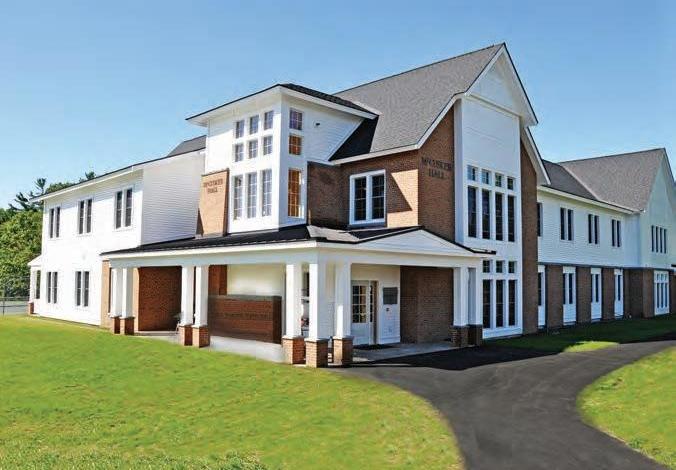
2016: The construction of McCusker Hall adds 26 additional beds to campus, allowing rooms in other dormitories to be converted into common spaces for advisory meetings and gatherings. Additional faculty residences are added as well, helping the School to attract and retain exceptional faculty and staff. 2020: Wallach is constructed to engage students’ intellectual curiosity and provide space for innovative design, applied engineering, and creative arts.
Renovations to Hayward and Clark-Morgan came first in 2014 and 2015 respectively. McCusker Hall, a 14,000-square foot dormitory with room for 28 students and four faculty residences, was finished in 2016. Named for Head of School David McCusker, it was a tribute to the unwavering leadership, strategic vision, and optimistic nature of the man who was helping transform the School.
TRANSITIONS
The three years encompassing Phase II quickly passed, and in 2018 The Campaign for Cardigan 2020 entered Phase III. The transition allowed for a shift in leadership as well as a change in focus. As David McCusker finished his tenure and Chris Day began his, the campaign turned its attention to the academic program, with the goal of defining and incorporating “a programwide teaching and learning philosophy that would embrace entrepreneurial thinking, innovation, risk-taking, learning from failure, and active learning (social/physical/intellectual).”
Critical to this phase of the campaign was the leadership and support of Ms. Wallach. “Diane responds to questions, not with answers, but with more questions,” says Mr. Day. “She works tirelessly to solve problems by empowering others to discover their own solutions. We all need the support of a team to help us reach our potential; Diane was that teammate for me and many others at Cardigan.”
In Phase III, Ms. Wallach’s matching gift provided the initiative to begin fundraising for a program that had been long in the making. “We knew that we needed to address our academic space,” Mr. Hutter explains. “But we didn’t just say, let’s shelve this thinking until we get through the other building projects. We kept it in the conversation because of the strategic plan, and therefore we were able to chew on it and chew on it through a couple architects, through evolving needs, and through plenty of time for different voices to challenge and think about it. And of course, what we ended up with—in the amazing Wallach facility and the academic quad and the changes we made to Bronfman—are so much better in terms of what we needed.”
Wallach and Bronfman opened their doors this fall. Entering the classrooms for the first time, it is clear that they are designed for collaboration and group projects. In Wallach, high top tables paired with stools invite students to lean in and work together. Large classrooms with ample space encourage movement and exploration. State-of-the-art equipment and plentiful supplies—smart boards and white boards in the Gates Lab, individual computer stations in the graphic design classroom, countless tools in the woodworking shop—aid the students in making discoveries and developing their ideas.
The renovations to Bronfman Hall are equally impressive. The Needham Gallery and art classroom on the second floor were transformed into science classrooms and labs, doubling the Science Department’s space and providing them with the flexibility to schedule longer blocks of time for fieldwork and in-depth reflections. The science classrooms are also equipped with prep rooms, where faculty can store equipment and prepare handson experiments. An additional outdoor classroom on the
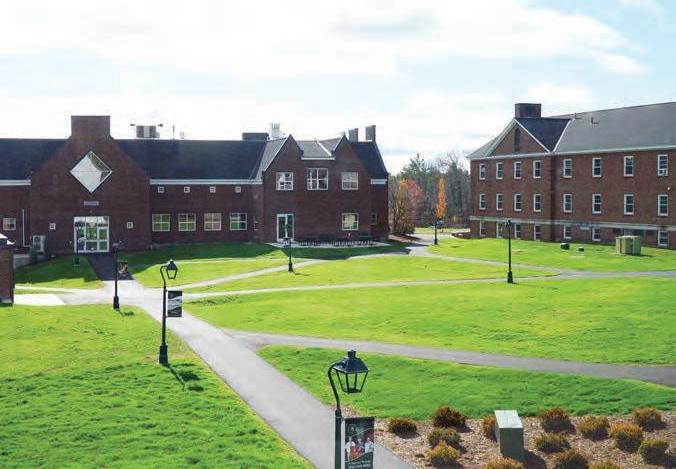
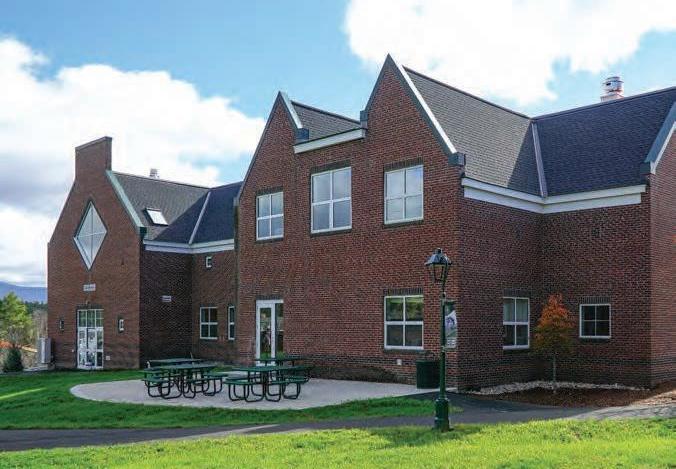
2020 2020
2020: Bronfman Hall is updated to enhance the Science Department program and provide students with the tools and technology to engage in hands-on scientific inquiries. An Academic Quad is created to unify all academic buildings and establish space for an outdoor classroom. The additional classrooms also allow for flexibility in the academic schedule, creating more opportunities for team-teaching and more time for science labs and artistic explorations.
academic quad is perfect for fall and spring escapes, acting as a staging area for scientific exploration in the natural world.
There’s no doubt that these new buildings—from the athletic facilities to the dormitories to the academic classrooms—transformed Cardigan’s programs, but the transformations weren’t just physical or limited to the lessons taking place within them. “The new facilities infected the way the rest of the School was thinking and motivated change,” reflects Ms. Wallach. “We’re going to be better as teachers. We’re going to be better in advising groups. We’re going to be better about how we deliver the product of education. It wasn’t just about bricks and mortar. That’s what we obviously raised most of the money for, but it permeated the culture into areas that had nothing to do with fundraising.”
When the campaign ended on June 30, 2020, Cardigan had extended its facilities by over 100,000 square feet and renovated over 70,000 square feet. The endowment had reached over $30 million and four new scholarships had been added to support a diverse student body. In terms of the adult community, staff responsibilities have been adjusted in support of work/life balance, helping to ensure that faculty members are always at their best and can see teaching Cardigan as a career and not just a job. Salaries have been brought into the median of our peer schools, professional development budgets have been enhanced, and a formal system of evaluation and improvement for all has been established. Programmatically, Cardigan has shifted its schedule, invested in technology, established clear methods for integrating and improving the academic program, and expanded resources to support the residential and advising programs. In short, the whole School has been affected by the campaign.
WHAT’S NEXT
As Cardigan celebrates its 75th anniversary, it would be easy to congratulate The Campaign for Cardigan 2020 fundraising team on a job well done and take a break. In talking to members of the current board, however, one gets a sense that there continues to be a sense of urgency.
“The momentum that we have going is fantastic,” agrees Chris Day. “It’s been exciting to watch our community using Wallach and Bronfman, and now I’m looking forward to the next thing, the evolution of Cardigan. I have my ideas, but the strategic planning process will involve the whole community—faculty, staff, parents, students, alumni—and it will be our cumulative vision that will lead us forward. I can’t wait to see where we go.”
With a global pandemic, climate change, and the rights of people of color at stake, the challenges facing Cardigan are significant. On the other hand, science has provided us with a more sophisticated picture of the development of a young child’s brain and the best ways in which to educate middle school boys. Now more than ever, as we face very real concerns for the future, the Cardigan community is energized for what is to come.
What seemed like an audacious goal ten years ago, we can now say is achievable, thanks to the hard work of countless individuals who never faltered in their dedication to Cardigan. The future may be uncertain, and the goals of the next strategic plan have yet to be written, but there is one thing we can say with confidence: our “why” and our mission will remain the same. The “why” will always focus on the boys. r






